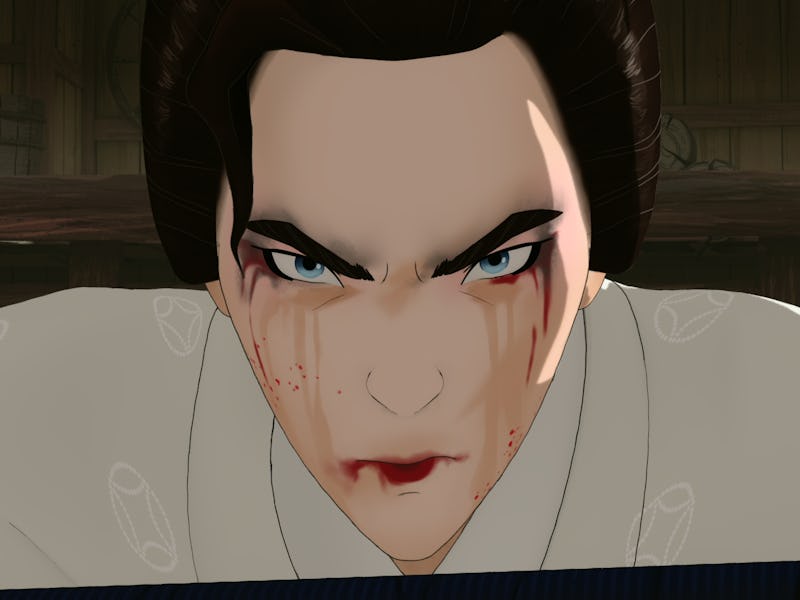Blue Eye Samurai's Best Episode is a Masterclass in TV Storytelling
This might just be the best TV episode of the year.

Netflix releases so many new TV shows and movies on a weekly basis that it’s easy for certain titles, no matter how worth your time they may be, to get lost in the shuffle. As a result, while some of Netflix’s legitimately great originals have been saved from the all-consuming nature of its production mill by online word-of-mouth and positive buzz, there are just as many films and series that have remained underseen and underappreciated. Fortunately, it doesn’t seem like that fate is destined to befall the streaming service’s latest adult animated TV series.
The show in question, Blue Eye Samurai, ranks firmly as Netflix’s best animated TV effort since 2021’s Arcane. Like that latter series, Blue Eye Samurai is a bold and ambitious TV show. It’s immensely cinematic in a way that very few animated TV series ever manage to be, and it’s so consistently thrilling and visually stunning that it’ll inevitably bring to mind action movie classics like Kill Bill Vol. 1, Lady Snowblood, and Yojimbo.
On top of all of that, the series’ fifth installment, titled “The Tale of the Ronin and the Bride,” might just be the best TV episode of the year.
Blue Eye Samurai’s fifth episode is thrilling, tragic, and terrifying.
Across its first four episodes, Blue Eye Samurai offers viewers a few select glimpses into the mind of its protagonist, Mizu (Maya Erskine), who was driven to her vengeful lifestyle by the bigotry and hatred she experienced as a child due to her mixed-race heritage. The show’s initial episodes do not, however, paint Mizu as anything more than a new riff on the kind of lone warrior archetype that viewers have seen plenty of times before. Thankfully, that all changes in “The Tale of the Ronin and the Bride.”
Picking up where Blue Eye Samurai’s fourth chapter left off, the episode follows Mizu as she attempts to protect the workers of a female-run brothel from the mercenaries that have been sent to kill them by a local, misogynistic crime boss. Still reeling from the trauma of a hit she’d carried out the night before, Mizu stealthily takes down each warrior that crosses her path — suffering numerous wounds along the way. At the same time, Blue Eye Samurai reframes Mizu’s present-day fight by cutting to a series of flashbacks set during a previously unseen period of her life, as well as a performance of a Japanese puppet show that is revealed in the episode’s final moments to be part of a larger flashforward.
The chapter’s flashbacks add new shades of emotional complexity to both Mizu’s past and her quest for vengeance. Its puppet show, meanwhile, highlights the parallels between Mizu’s story and that of an onryō (i.e., a vengeful spirit) — elevating her journey to mythic heights. The episode, which was directed by Michael Green and written by his Blue Eye Samurai co-creator, Amber Noizumi, cuts so fluidly between its three timelines that it achieves a kind of propulsive, balletic grace. In its final act, “The Tale of the Ronin and the Bride” then collapses its levels of reality in a pair of duels that are not only astonishingly violent and well-choreographed but also terrifying in just how nakedly they reveal the intense pain burning at the center of Blue Eye Samurai’s protagonist.
"The Tale of the Ronin and the Bride" is a brilliant, nesting-doll episode of television.
Blue Eye Samurai Episode 5 is a perfect example of what episodic TV storytelling can produce. It wouldn’t work without the foundation provided by the four chapters that precede it, nor could it stand on its own as a feature film.
The episode can exist only how it does, which is as a structurally ambitious, nesting-doll experiment in visual storytelling that both redefines everything you’ve seen before it and propels the show’s overarching narrative forward. It fulfills every one of Blue Eye Samurai’s promises — delivering a handful of unforgettable swordfights that inspire awe and offer new insight into the volatile mind of the show’s eponymous warrior. In case that wasn’t enough, the episode also ends on a gut punch of a final image, one that recontextualizes the damage wrought by Mizu’s insatiable hunger for vengeance yet again.
To put it simply: "The Tale of the Ronin and the Bride" leaves a lasting impression. Few of this year’s TV shows have managed to deliver episodes that are as unique and powerful as it. Consequently, while there’s plenty to recommend about Blue Eye Samurai, the series is worth checking out for its fifth chapter alone. The show’s aggressively adult tone may alienate some viewers, but anyone hungry for a genre thriller that is as emotionally engaging as it is stylistically impressive won’t be left disappointed by Blue Eye Samurai.
Blue Eye Samurai Season 1 is streaming now on Netflix.
This article was originally published on